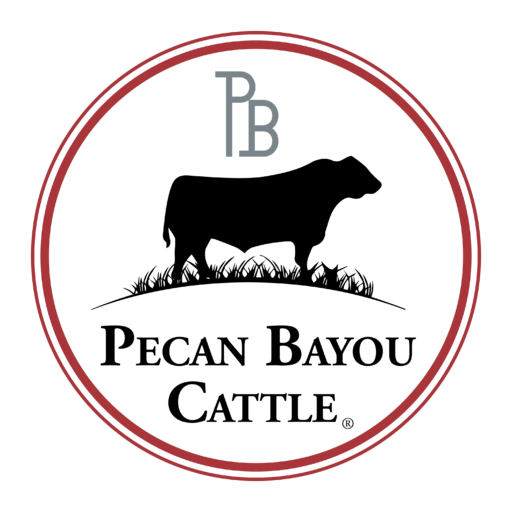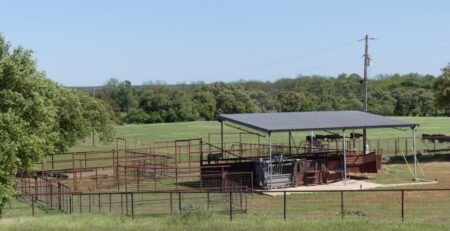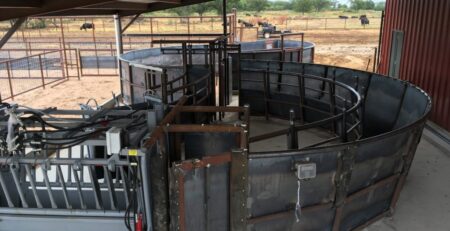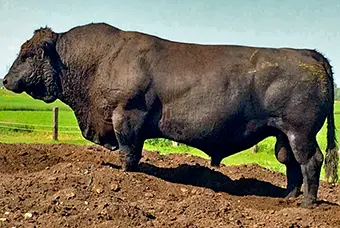
Fertility is the single most important economic trait for cattle ranchers.
A bull must be fertile, have high semen quality, and high libido or drive. Bulls must have a proper hormonal balance and cover their herd. Jan Bonsma was a famous cattle scientist who traveled the world during the last century. He could look at cattle and judge their fertility. Mr. Bonsma noticed visual traits that predicted fertility. His methods work for all cattle breeds.
Fertility is a highly inheritable trait. This means if you buy a fertile bull, he will likely sire fertile daughters. So, if you learn to look at your bulls and cows like Jan Bonsma did, then you can make better decisions for culling and developing your herd. According to Jan Bonsma’s landmark book on cattle production, “Man Must Measure” written in 1983, the following traits are what you should focus on when you buy a bull.
A Bonsma style looking bull, has a very masculine look, developed front shoulders and neck, with a narrower back end, large testicle size, tight sheath, and a slick hair coat in the summer. For cows, it is a narrow, thin feminine neck and shoulder, with a wider middle and back end, and a visible crease in her dewlap brisket area. Here’s a link to an article in the Angus Journal about Jan Bonsma: Angus Journal Link.
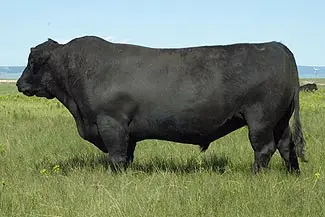
Body Type for High Fertility Bonsma Style Bulls
Other Considerations
Will you retain heifers?
Buying a bull with strong maternal bloodlines would be a good idea if you want to retain heifers. Many bulls, and their sires have great cows in their bloodlines, and are bulls known for producing great, feminine, Bonsma style cows based on their lineage.
Will your bull breed heifers?
Will your bull breed heifers? If so, you will want to look for a small head, smooth shoulders, without any bony points or protrusions on the bull’s hips. You will want his calves to pass through the birth canal without problem. Longer-bodied bulls often have calving ease, lower birth weight calves. If you buy an Angus bull to breed to other breeds, you will likely be okay with a larger bull, because Angus cattle tend to be more moderate framed breed than other cattle breeds.
Will you or your family be near the bull or will he be in a big pasture area?
Docility is very important. You will want to observe the bull. Walk around near him when you are viewing him. If he seems nervous, “high headed” or spooked, you may want to pass him up. Buying a calm, easy going bull, is the best decision you can make. This is especially true if you or your family will be in close quarters with him often.
No bull is a pet, or “trustworthy” and because they weigh over a ton, even a calm bull can be a threat when handling them. Docility is a highly inheritable genetic trait. There are certain Angus bloodlines known for creating calm, gentle offspring. If you select a gentle, docile bull, his calves and heifers will tend to be calm as well.
Ask the breeder about this important trait of gentleness in their bulls to add to your herd. Also, if the cattle breeder often handles the weaned calves, young bulls, and sale bulls with routine exposure to people, it tends to tame the bulls down a lot.
What feeding program will you have for your cattle?
If you buy a bull from a breeder that feeds bulls corn or grain before the sale, they will need some time to adapt to your pasture and breeding program. Bulls that are “fed out” or “fattened up” to fetch the highest price from the buyer at the sale will often “fall apart” when they are turned out with a cow herd for breeding. They lose body condition and should be watched closely within the first two months in case they need to be rested. Fertility can also be permanently impacted if they can’t cover their ratio of open cattle while also adapting to the weight and muscle loss due to the lack of constant grain, hot feed, corn or rations that they received at the breeder. You may need to supplement the bull with additional feed during this adjustment time.
Ask the breeder what their feeding program was in order to prepare for protecting your investment in your bull. If you can find a breeder that doesn’t feed out or fatten up their bulls, consider buying your bull from them. Remember a bull doesn’t fully mature until he is 4 years old. When you buy a 15 month to 2-year-old bull, he still has a lot of growing to do to mature naturally. However, they eventually even out and reach their genetic potential, most closely predicted by their parent’s mature size and weight.
What type of calves or offspring sell well in your area?
Ask around locally to find out what type of calves sell best in your area. If you will be selling calves at a sale barn, raising feeder calves, or raising beef cattle for pasture-to-table, then consider what breed of bull fits best with your operation.
What type of cattle are you breeding to, horned, motley-faced or red?
When you breed certain cross breeds, you can often predict what color the calves will be, or whether they will have horns. This is because in cattle genetics, certain traits are dominant, and others are recessive. For example, Angus are polled (meaning no horns), but Herford have horns. Many Herford breeders saw-off the horns, which can lead to infection.
Black hair is dominant over red haired cattle. Charolais have a white “dilutor” coat, which means the color will dilute, to a chocolate milk color if bred to Angus or black cattle. These factors may not matter to your operation, but because a bull is half of the genetics of your herd, it may be something to consider when buying a bull.
How many cows do you have in your herd?
A bull can generally breed 25 cows per year. There are other factors, like whether all your cows are open at the same time, with timed-calving or whether your cows calve, and come open on a year-round basis. Many bulls may be able to breed more than 25 cows, but pushing bulls beyond their limit could negatively impact their long-term fertility, and could lead to open cows, or delayed calving which effect the rancher’s bottom line.
Do you have good fences?
Virgin bulls tend to stay home with their herd, but not if there aren’t enough cows to keep him busy. A good bull will view his job as servicing cattle, even if those are the neighbor’s cows. Having good fences and a proper stocking rate will help maintain a good balance in your herd and decrease problems.
What is your budget?
A good bull can last up to around 8 years, or possibly even longer without heavy competition, and with good grazing to keep his teeth in good shape. Many ranchers have non-pure bred or “commercial” cows, but they purchase a registered or purebred bull as a way to improve the genetics of their calves and cow herd. It is a lot cheaper to buy a nice bull, than a whole herd of purebred cows.
Registered Angus bulls can range from $2,500 to $10,000 or more at an auction. The average price is between $3,500 – $5,500 for a young Angus bull. Angus bulls are considered adaptable and versatile. the Angus association has done well in marketing Angus cattle, which helps them retain market share and desirability from ranchers and for beef consumption based on high marbling and carcass quality.
